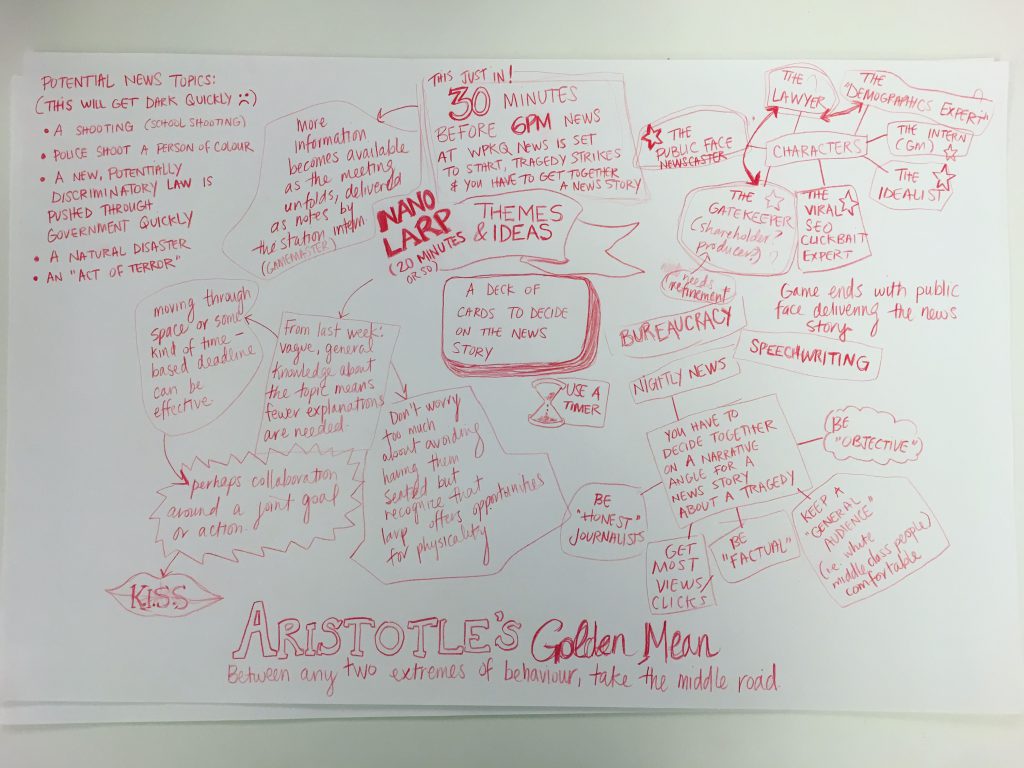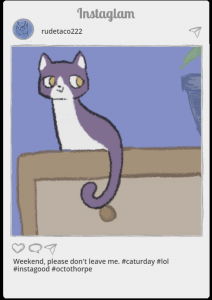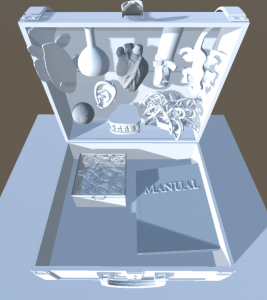[Content Warning: Chronic pain, bodies, bodily fluids, personal information related to said topics]
This week, I’ve been thinking a lot about instructions, deictics [1] and grammar related to situating the person receiving the instructions in the present. Using Alison Gibbons’ work as a starting point, I’m interested in the topic because of how it might help players identify with a character. In Blast Theory’s Ulrike and Eamon Compliant, this type of language brings the player closer to the identity of one of two terrorists, either Ulrike Meinhof or Eamon Collins.
I was planning to prototype an exploration of the subject matter this week, but became ill, which has led me to thinking through a much more personal subject than I had originally anticipated: pain, illness, and embodiment. As I write this I have a low fever and the flu. In this post, I’m going to position my own experiences with the aforementioned subjects, which means I’ll be talking a fair bit about my personal experiences with chronic pain and illness.
Nothing brings the notion of embodiment crashing back into view like a body that is ill or injured. In Elaine Scarry’s The Body in Pain, the author elucidates how our own pain is immediate but the pain of others is almost impossible to relate to. “Pain separates us,” Scarry notes. Even though we might be just a few inches away from someone who is in pain, their pain is remote. We “invoke analogies to remote cosmologies.” Scarry discusses how pain can rob a person of their speech and how others, even though they do not have direct access to a person’s pain, may explain or attempt to metaphorize their pain to bridge that gap. Direct descriptions of pain are passed through very quickly and instead we get “as if” and “as though” descriptions. These descriptions picture an external agent to pain, and bodily damage to accompany the pain. How these metaphors work is problematic because they do not adequately describe pain as divorced from violent actions, or from the act that may or may not have actually caused the pain — for example, “it feels as though a hammer is coming down on my spine.” As Scarry tells us, “Physical pain is not identical with (and often exists without) either agency or damage, but these things are referential. Consequently, we often call on them to convey the experience of the pain itself.”
Perhaps the fact that I live with a fair bit of chronic pain and illness is one of the reasons why I am so interested as a designer in the subject of embodiment. So rarely am I able to forget my own body completely and become “involved” (in Calleja’s sense of the word) that I rarely, if ever, forget the player’s body in my design work.
Just so that there are no surprises, and in case you’d like to skip over these sections, I am going to tell you about my experiences with chronic pain and other chronic conditions, starting with the back and leg pain that I live with.
From a young age, I had a tendency to hyperextend my knees when told to stand up straight. When I was fourteen years old, I wanted to join karate because I had a crush on a boy. As it turned out, there was no room in the junior class that he attended, but I joined anyway. I always have been into team sports, playing football from ages 7-12, and being on my school’s swim team. My brother soon joined me as well, and I attended karate for eight years, earning my blue belt, and stopping while training for my brown belt. It is through karate that I found out that I have an abnormally high pain tolerance. Karate, despite the kindness of my teachers, was occasionally a problematic, male-oriented space. Advanced belts were encouraged to join the advanced class, which I did, where I was generally the only non-dude. There was subtle encouragement to work and train through the various kinds of pain we encountered. We were barefoot at all times in the dojo, and began each class running around in circles on the hardwood floor. I made a habit of running on the balls of my feet (which is not good). I also had a wicked front and side kick (which put strain on my feet).
During the time that I was in karate I also worked for a number of years at a sushi shop. Once a week I would complete one twelve hour shift spent entirely on my feet. During this shift, and in other contexts, my feet were constantly sore. I used to tell myself that I must get sore feet from working that twelve hour shift, and since I only did it once a week my body could not get used to it. Eventually, I mentioned it to my doctor who sent me for X-rays. My doctor was astounded to find that I had multiple microfractures in my feet, which had healed poorly, and were leading to pain. I had basically broken my feet multiple times without noticing. This was the beginning of an ongoing saga involving my lower back, legs, knees, ankles, and feet. I somehow gave myself a stress fracture in my right arch, and for half a year could not do high impact sports. I saw a physiotherapist for both my knees and my ankles, which would give out on me painfully. I discovered that my tendency to hyper-extend my knees, as well as the microfractures in my feet, led to a number of other problems and alignment issues. My leg muscles are extremely tight. There is a nerve that runs from my lower back, to the outside of my thigh, into my knee, down the front of my shin, and into my ankle, in both of my legs, that is constantly being trapped by my tightened muscles. I have a number of stretches that help alleviate the pain, but when the pain is tolerable it can be hard to prioritize an hour’s worth of physiotherapy stretches in my everyday schedule. I also roll out my muscles every night with the help of my spouse, and I wear orthopedic insoles in my shoes. Truthfully, the pain never really goes away for long, and I have to be constantly vigilant for signs that it is worsening.
This next example deals with a normalized disability that plenty of people in the world have, and I want to contrast that experience with another chronic health issue that I have. From the time that I was thirteen until January 2017, I wore a combination of glasses and contact lenses for a fairly strong prescription. Since I needed them to do most sports that I was involved with, including scuba diving, swimming, and karate, I had a number of learned behaviours and rituals around my contact lenses. For example, when working at the Sushi Shop, I used to put in my lenses when I got to work. I had to wash my hands very carefully, and dry my hands with paper towels. These had to be the white paper towels, which we used for food preparation, and not the brown paper towels that we were supposed to use to dry hands, because the brown paper towels were much more likely to leave dust and filaments on my hands. Even with all this careful preparation I still often felt a foreign object sensation in my eyes after putting in my contact lenses. (I later discovered that I have dryer than usual eyes, a symptom of which is a foreign object sensation). Another learned behaviour that I have is never opening my eyes underwater as long as I wasn’t wearing a mask. I’ve also changed into my lenses in all sorts of contexts and locations, from the middle of forests, to outhouses, to truck stops, and gas stations. I always had to carry my glasses, a bottle of saline solution, my contact lenses, and a set of back-up lenses. I thought for sure that one day I was going to give myself pink-eye, or some other eye infection. Since glasses and minor sight problems are a totally normalized disability, I never thought twice about all of the preparation and ritual involved with my sight. Having laser eye surgery, although there were hassles in the short term, has been life changing in terms of how I travel and how I participate in sports. I’m only now learning to open my eyes again underwater, which I now realize was a constant low-level stressor throughout my scuba diving career. That is to say, the thought that I might lose my mask and be blind underwater was a constant stressful possibility.
At this very moment, I have the flu, and I may have in fact ignored the symptoms for a few days because of another chronic condition that I live with. This one is a good deal less easy for people to understand compared to glasses. I have a postnasal drip, which basically means that thicker than normal secretions run from my nasal passage down my throat. To be clear, the secretions part is normal, but they are usually thin enough that the average person just swallows them without noticing. My postnasal drip is constantly filling my throat with thick spit, which obstructs the passage and occasionally, when it is very bad, makes me feel like I am choking. I constantly have to clear my throat and spit, or deal with the feeling that I am choking. So, occasionally, when there are no other options, I have to spit outside in public, or have to use a napkin or other receptacle to clear my throat (and some people are less than understanding about this). Accompanying this is a constantly runny nose, most of it water. As a result, I carry a handkerchief everyday (the alternative being a large box of tissues), and blow my nose frequently. There is a corticosteroidal nasal spray that helps to alleviate the problem somewhat, although when my seasonal allergies are at their worst, it can have little effect. At night, I use a humidifier and an air purifier to help with allergy symptoms and prevent my mouth from drying out too badly, and I drink a lot of water.
Still, occasionally, my postnasal drip acts up and causes me to cough up a lot of spit, and since I had let my prescription for the nasal spray lapse of late (switching between Montreal and Fort McMurray has its challenges in terms of keeping prescriptions active), I thought that my coughing in the past few days was simply the aggravated drip. Today, I was running a fever, had the chills, and was coughing up phlegm that was decidely not mostly water, which brings us up to date.
My body, and I imagine the bodies of others, has grown accustomed to pain and to ignoring it, especially if new and exciting pain is drawing my attention. Still, pain is a constant presence in my life, especially in my back and legs. It affects what I am able to do, and it never completely fades from view.
Deictic language was useful in Blast Theory’s Ulrike and Eamon Compliant because it continuously pulled the player’s attention back and involved them in their immediate surroundings. Coupled with the use of “you” to address the player, and the simple actions that the player was called upon to perform while being addressed as either Eamon or Ulrike, deictic language helped players become involved and identify with the stories of a type of person that we would rarely want to be seen as identifying with — a terrorist.
Thinking through how this might connect up with embodiment and pain or illness, there are a number of practices from psychology that operate by creating a focus and awareness of the subject’s body. Many forms of meditation, relaxation, and hypnosis ask participants to focus on their breathing, for example, and taking slow deep breaths. Similar methods exist for controlling pain, such as the Lamaze method for childbirth.
My Master’s thesis, which attempted to translate the technical aspects of scuba diving into a readable dimension of a collection of short stories, often dealt with breathing, as this is core to the experience of scuba diving. Awareness of one’s own breath can make the difference between a long or a short dive, but also the difference between life and death. I found that, by mentioning breathing in these stories and making readers aware of their own breathing, these sections often had a dramatic effect. Readers reported feeling unsettled, claustrophobic, and in some cases, close to panic. This makes me wonder about the use of bodily awareness in player instructions for creating experiences in the vein of Ulrike and Eamon Compliant.
In my personal life, I constantly have to read the needs of my body, and am also quite bad about ignoring symptoms that I shouldn’t, due to my experiences with chronic pain. If I could see into another person’s experience with their body, since humans experience embodiment every day, I wonder how similar our experiences would be. Scarry’s work suggests that we cannot know another’s pain, even in relation to our own, and that furthermore, even our own recent pain quickly becomes inaccessible to us. Now, I’m not suggesting that I want to create a series of malevolent instructions that would cause players pain, but I wonder how creating bodily awareness and thinking through rituals related to caring for our bodies might be used in embodied game experiences.
[1] From ThoughtCo: “A deictic expression (or deixis) is a word or phrase (such as this, that, these, those, now, then) that points to the time, place, or situation in which a speaker is speaking.”
WORKS CITED
Blast Theory Theatre Company. (2009). Ulrike & Eamon Compliant. [Performance] Venice,
Italy: Venice Biennale.
Calleja, G. (2011). In-game. 1st ed. Cambridge, Mass.: MIT Press.
Gibbons, A. (2014). Fictionality and Ontology. In Stockwell, P. and Whiteley, S., eds., The Cambridge Handbook of Stylistics, Cambridge: Cambridge University Press, pp.410-425.
Scarry, E. (1987). The body in pain. 1st ed. New York: Oxford University Press.
ThoughtCo. (2017). Deictic Expression (Deixis). Website.
https://www.thoughtco.com/deictic-expression-deixis-1690428



